Trending
Opinion: How will Project 2025 impact game developers?
The Heritage Foundation's manifesto for the possible next administration could do great harm to many, including large portions of the game development community.

Featured Blog | This community-written post highlights the best of what the game industry has to offer. Read more like it on the Game Developer Blogs or learn how to Submit Your Own Blog Post
Autochess was the hottest gaming trend in 2019, but not anymore. We explore its history, market status and audience, and the design flaws that stopped it from becoming "the new MOBA".


In January 2019, Drodo Studio’s Dota Auto Chess mod became insanely popular. Many companies (including household names like Valve, Riot, Ubisoft and Blizzard) rushed to release their own versions.
It seemed like the beginning of something big like MOBA or Battle Royale. But it has been more than a year now and the hype seems to have vanished completely. As quickly as it rose, it went away…
This is the first on a series of articles where we will analyze the autochess genre. Here we will be exploring the genre’s history, its current market situation and its audience. And also, what are the core design issues that autochess suffers and that no one has been able to solve yet.
@JB: For this article I’m teaming up with my mate Victor Freso, one of my most talented folks at Pixel Noire Games, who helped me review all the games.
We also had feedback of ~300 highly engaged players from the different autochess reddit communities, which participated in an online poll whose results are available here. They’re especially thanked at the end of the article.
This wasn’t the first time that a mod got the spotlight and ended up becoming the foundation of a genre. It happened in several major, industry-defining cases before (some of which are Team Shooters, MOBAs, Battle Royale…).
But on some of these cases events unfolded differently. So we identify 3 distinctive eras related to the evolution of the industry:
The company whose original software had been modded (or had a close enough game, like Valve) moved quickly to absorb the successful mods and turn them into even more successful products.
Since at that point creating a major game release was very complex (required an expensive development, publishing deals and an infrastructure to distribute the product), the deal was profitable for both sides.
But it meant the dissolution of the identity of the original creator team, which became embedded in the bigger company culture.

Team Fortress (1999) was originally a Quake mod. And Counter-Strike (2000) started out as a fan-made mod on the Half Life engine. Both games (and creators) were quickly absorbed by Valve.
By this time, the previous era model still was going on… but the gaming industry had significatively grown a lot and it was also possible for smaller or even new companies to lure the original developers, and use the mod as a proof for commercial success in order to secure funding and develop it as a full title.
The main characteristic of this era is that the original developers were able to keep a bigger share of control and relevance, rather than being integrated as just another gear on a bigger machine, because the companies they joined built their own identity around that key product.
This was the case of Riot Games: They were able to raise enough money for the creation of their company through family and angel investors, and then hire some of the original creators of DOTA, and then created League of Legends.
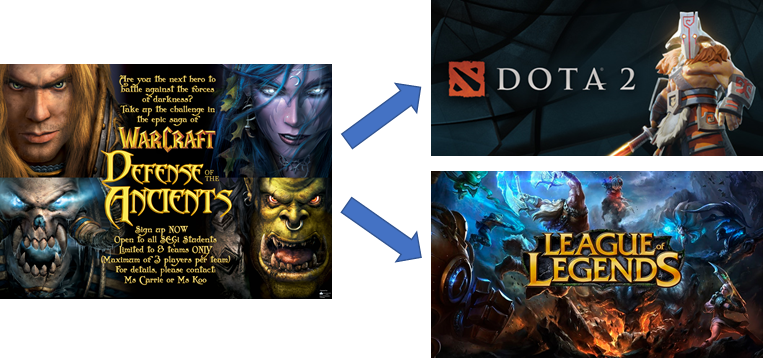
Defense of the Ancients (DotA), the foundational title for the MOBA genre, appeared in 2003 as a fan-made custom scenario of Warcraft 3. Foreseeing commercial potential on a full game based on the concept, Riot games and Valve both battled for the Dota IP and the original developers, eventually releasing rival titles League of Legends and Dota2. Interestingly, Blizzard (owners of Warcraft 3) tried to replicate the success without the mod creators in Heroes of the Storm (2015), which hasn’t been as successful as the other two.
A similar case happened with battle royale, which also started in 2013 as a successful DayZ mod created by the modder nicknamed PlayerUnknown.
Later, it was transformed into a full product through the acquisition of the developer by a korean company (which would later be renamed as the PUBG Corporation, again showing how the company grew around the game rather than assimilating it).
Interestingly, this genre already hints what would happen with Auto Chess, since Fortnite wasn’t involved in any way with the original creators. They just copied the concept.
Fortnite was a product stuck in a kind of development hell (had been 6 years in the works). As the game was getting close to the release, the developers became impressed by PUBG’s success, so they created a quick Battle Royale spin-off which became insanely popular and eventually ate the rest of the game.

Player Unknown’s Battlegrounds (2017), foundational title of the modern battle royale genre, is the successor of PlayerUnknown’s DayZ: Battle Royale, a popular mod for DayZ (which on itself is a mod of ArmA3, making it a mod of a mod lol). The success of PUBG inspired Fortnite (a title on the later stages of a troubled development at the time) to spin towards that genre, becoming PUBG‘s main competitor.
In all the cases presented previously, the newborn genre ended up in the release of one or two titles which accumulated most of the business. But this hasn’t been the case here.
In Autochess, the newborn genre has been quickly fragmented into a big list of competitors. Some are standalone games (like DOTA Underlords or Autochess: Origins), but there’s also several service-model games which released their autochess mode as well (like Hearthstone’s Battlegrounds or TeamFight Tactics, which at the end of the day is a side-game mode of League of Legends).
This creates an interesting precedent, which I believe will define future cases where an innovative new game concept appears: The hot idea will be cloned very fast because today the main bottleneck in the industry is having an innovative design that generates player interest and engagement.
By 2020, it’s way easier to create and distribute a game, there are way more developers hungry for a hit than ever before, and a lot of service-model games with short development cycles always looking for something juicy for their next update… so new ideas becoming red oceans fast will be the norm.
For sure, this won’t affect the ability of small developers and modders to innovate, but it will affect their ability to leverage that to become successful on an independant level, before they get cloned.

Dota Auto Chess, was a Dota 2 mod which obtained massive popularity. After a failed acquisition from Valve (owners of Dota), the mod developers (Drodo Studios) went to create the mobile standalone Auto Chess: Origins, while still maintaining the PC version linked to Valve. Meanwhile, Riot, Valve, Ubisoft and many other companies developed and released their own autobattlers at a record time, downgrading the genre creators to just another competitor.
On Autochess, the fragmentation and fast release pace came at the cost of innovation, though. These games feature few unique selling points compared to the original DOTA Autochess experience: TFT’s ‘anti-snowballing’ character selection rounds, Underlord’s bosses and fast-track mode….
And ultimately, they haven’t fixed the core issues of the original game, which separates it from a true hyper-successful product like MOBA.
Because of the rain of clones, it’s hard to map all the autochess games on the market.
It doesn’t help that some of them are available in both PC and Mobile (playable in PC, Mac, Android and iOS), and also they’re exclusive to different PC stores (Dota Underlords is only on Steam, TFT is on Riot’s LoL launcher, and Autochess Origins is only at the Epic Store…).
And if that wasn’t enough, the Auto Chess mod in DOTA2 is still very active and has no signs that it’s going to be dying soon. It’s still being regularly updated, and presumably still profitable: Some months ago they added a battle pass system, with its revenue shared between Valve and Drodo.

What’s interesting is that none of the contenders has been able to become massively successful in terms of monetization, at least not in terms comparable to even a second or third tier MOBA.
And while there are definitively different tiers of following among these titles (led by Riot Games’ TeamFight Tactics), it seems that none of them has been able to gather under its banner a significant amount of players, mobile downloads or Twitch Views…

Sources: AppAnnie (mobile metrics), TwitchMetrics (twitch)
So ultimately, we’re dividing the autochess market into 3 categories: Squires, Would-be Kings and Peasants.
Squires: Rather than standalone games, these are side-modes of already successful products. Under this category we would list the Battlegrounds mode in Hearthstone, or League of Legends’ TFT, and maybe even the original DOTA Autochess mod.
While for sure they’ll have their own dedicated audience that only plays those modes, for most players it’s just a nice and fresh activity integrated within a broader game experience.
The squires are the ones that have achieved the biggest success among the autochess genre because they don’t suffer as much backlash from the lack of gameplay depth inherent to the genre, which is harmful for the long term retention: Even if the mode eventually becomes a bit shallow, players have many other things to play, and thus are retained.
As a consequence, these games can still monetize significatively by selling renewals of their Battle Passes every new season. Not enough to make them successful on the degree that was expected… but at least it’s something.
Other than bringing an additional source of revenue, these modes were useful to their core games: They generated player interest by providing innovative gameplay.
Hearthstone’s Battlegrounds was an amazing addition to the CCG genre, and made a lot of people come back to the game to discover the new mode and reengage.
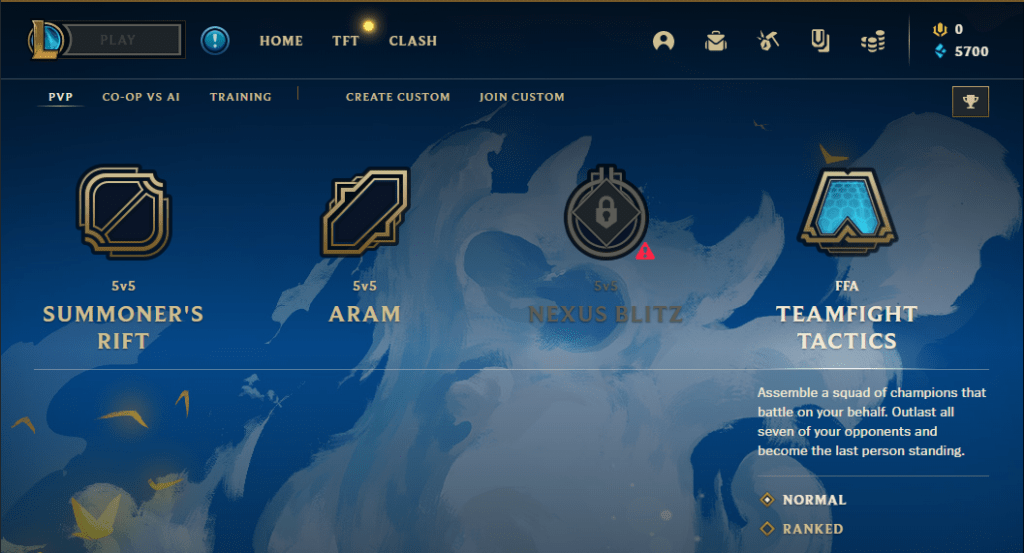
The gameplay of TeamFight Tactics (slow tempo, no team coordination, decreased attention requirement…) makes it a nice relief mode to play between LOL matches, which is its purpose in the foreseeable future. If there ever was an intention to make it a standalone game, it vanished together with the player interest on autochess…
Would-be Kings: These are the other two top dogs of the category. They were supposed to rule… but that looking at the numbers they don’t really seem to have ever lifted off. Under this category we would list Auto Chess: Origins and DOTA Underlords.
The problem is that their standalone approach means that they suffer the most of the design issues of the genre that we’ve presented in the last section of this article (i.e. flat complexity, lack of mastery depth, lack of progression and rotative meta…).
That means that they lost a lot of population over time, and therefore their Battle Pass renewal isn’t as effective at generating revenue : (
![Dota Underlords -- The Big Update! [Now with *actual* Underlords] - YouTube Dota Underlords -- The Big Update! [Now with *actual* Underlords] - YouTube](https://i.ytimg.com/vi/hyvQICvwfRs/maxresdefault.jpg?width=700&auto=webp&quality=80&disable=upscale)
DOTA Underlords is an extremely polished product in terms of graphics, character design and UX, and yet another proof that Valve devs really know how to do great games. Too bad they aren’t as good at releasing third installments.
Peasants: Here we would list the myriad of other autochess follower titles that entered the battlefield, each achieving a different degree of success.
While some may actually be profitable, what we can be sure about is that none of them has reached any significant numbers or anything close to the reach that brought industry attention.
We are of the belief that you can’t talk about a game and not talk about who plays it, and that players say more about a game than analyzing all its features and mechanics.
So with this in mind we collected answers from ~300 autochess players (check the raw data here). After examining their responses, we’ve identified 3 main player profiles (the comments on each profile are literal):
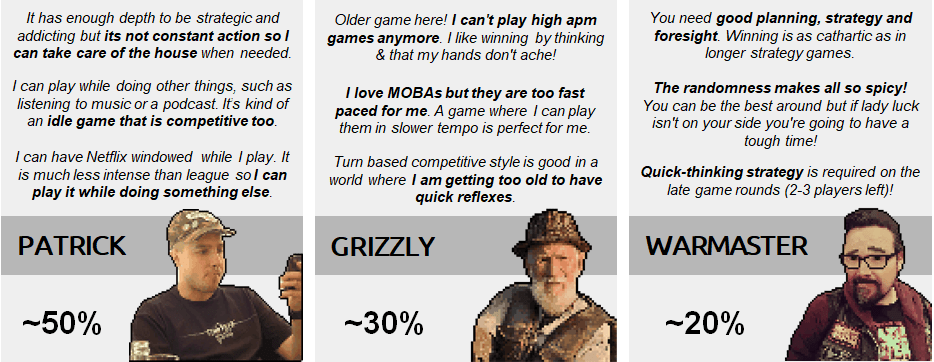
Patricks, gamers looking for a competitive-but-idle experience that doesn’t require full attention and it’s easily reconcilable with their functional adult life.Grizzlies, competitive players that struggle with fast paced games that demand a high actions per minute ratio and quick reflexes (like MOBAs or competitive shooters).Warmasters, highly competitive players that enjoy more the area of strategy (setting up goals and planning how to achieve them) rather than tactics (skillful execution of actions and micromanagement).
What these profiles have in common, other than being hardcore gamers and having a big interest in competitive games, is the fact that they enjoy the lack of micromanagement, and the demand of reflexes and dexterity of autochess.
This is quite interesting, considering that the genre foundation is so close to MOBAs, which are extremely demanding on those aspects. Overall it seems that they belong to audiences below the MOBA umbrella which are currently being alienated by the bulk of ‘younger and dexterity focused’ players.
And when it comes to platforms, it seems that even though the barrier between the classic gaming platforms and mobile is progressively disappearing, the genre is still mainly focused on PC:
Out of the ~300 players that answered, 50% said that they play exclusively on PC, 25% played primarily on Mobile, and the remaining 25% played in both.

Players said that they enjoy the focus of the game in planification, as opposed to the focus on execution and performance of MOBAs. And when asked about their main points of frustration, they pointed out 2 main topics: 1.- The strong luck factor that has a strong impact on making you win or lose regardless on how well you played. 2.- The fact that the game eventually becomes shallow and repetitive, fueled by the fact updates were unexciting and not rotating the meta.
Surprised by the fact that players mention randomness as a factor of both enjoyment and frustration? Don’t be!
Competitive players tend to have a love-and-hate relationship with luck, because they tend to consider that external factors outside of skills (money spent, better draw…) stole their well deserved victory.
And it’s even more frustrating in autochess, because there’s a strong snowball effect: Players that obtain a big advantage early on in the game become hard to catch later on. Which means that a few bad or good draws early on can decide the rest of the match.
There hasn’t been a single feature more criticised in Magic: The Gathering than the randomness of drawing mana. And yet, luck it’s part of what makes MTG stand out compared to other CCGs:
For experienced players, it introduces uncertainty and the need to take risks and gamble, like they’d do in poker.
And for rookies, it allows beating someone that has better skills and has a better deck, if Lady Luck is on their side. Won’t happen often, but it will feel awesome when it does.
Like a friend likes to say: The best feeling in MTG is to draw a mana when you really need it. And the worst? To draw it when you didn’t.
This goes to say that in autochess, perhaps the power of luck needs to be reviewed, but it would be a bad decision to completely remove luck from the equation.
In this awesome DoF article, Giovanni Ducati already pointed out the two main problems that the games in this genre need to solve to achieve real success: Bad long term retention and low monetization.
To these issues we would add a third one, which is bad marketability:
Contrary to their big brothers League of Legends and DOTA2, these games haven’t been able to achieve high organic downloads (at least not to be able to generate significant revenue through soft monetization mechanics).
What’s even worse is that all these games, their themes and target audience are quite close to RPG and Strategy, which are genres with some of the highest CPIs on the market. So they need top-of-the-class retention and monetization to get a high enough LTV to scale up.
But why do these games fail at keeping players entertained for a long time?
And why don’t they monetize enough? Here’s what we think:
You have some games out there which have a strong entry barrier due to being quite complicated to grasp. But for those that can deal with the numbers and stats, the depth will keep them entertained for months and years. This is the case in most RPGs and 4X strategy games.
And then you have hypercasual games, which are simple and plug and play. So they generate a great early engagement, but are too shallow to keep users hooked for a long time.
As a genre, Autochess games are in the middle ground: they have a high entry barrier, but also lack the complexity to keep players engaged for a long time…
As a general rule, games with long retention tend to follow Bushnell’s Law of being easy to learn and difficult to master. They achieve that by having what we call an unfolding experience: They appear simpler at the beginning (not necessarily easy), but require thousands of hours of practice to master.
An example of this are games that level lock most of the game complexity, so the player understands and masters only a set starter mechanics.
And then, progressively unlock new modes and demand more specialized builds and gameplay, repeating the cycle several times to keep the game always interesting while attempting to avoid being overwhelming.
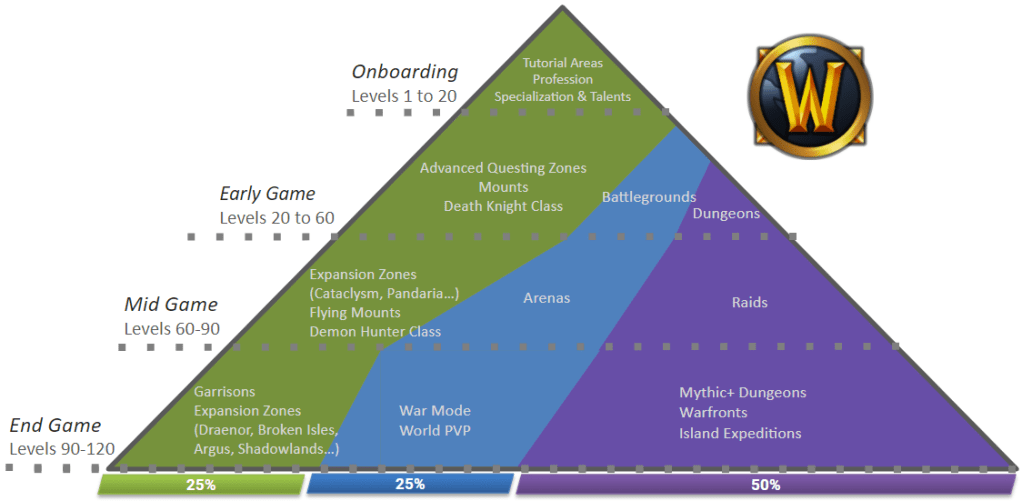
In World of Warcraft, character depth is huge. But this complexity is unfolded progressively, forcing the player to spend time mastering each skill and activity as they level up, before moving further.
Another approach to the same idea are competitive games focused on mechanical ability, dexterity or micromanagement. Like CS:GO or Rocket League.
They may unlock all the mechanics from the beginning, but a newbie player will only be able to focus and manage some of them, and then progressively discover and master the rest in an organic way.
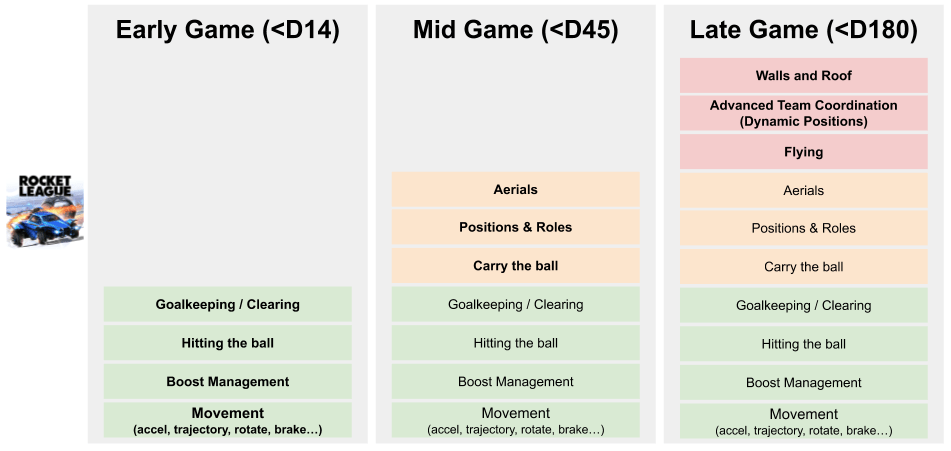
Rocket League hides its complexity by matchmaking early players with others of a similar skill. This makes beginner players viable even if they grasp only the basic mechanics. But, as they climb further, they’ll face rivals that take those basic skills for granted and the player will need to master more challenging techniques to keep up.
League of Legends or Overwatch are actually a combination of both:
The game first introduces the player to a small selection of heroes which progressively gets expanded, while at the same time having an insane mastery depth that requires a high APM and reflexes, team coordination and thousands of hours of practice.
Contrary to any of those examples, Autochess games throw everything at you from the beginning: Character Skills, Synergies, Unit Upgrade, Gold Management, Items… It’s a lot to swallow. And there’s not even enough time to read what each thing does before the timer runs out. This creates a complex, overwhelming first impression that drives many players out.
But that’s quantity, not depth. Once you’ve gone through that traumatic starting phase, you’ve grasped all the mechanics and you know which team builds are dominating on the meta, it becomes a bit stagnant.
Now, let me clarify this point: Same as in poker or majhong, because the choices of other players affect your own probabilities and best decision picks, the game is almost impossible to master.
But that level of the game so unaccessible and technical, that leaves out the big bulk of players (even highly engaged ones), who feel a plateau.
So ultimately, these games are hard to grasp for a newbie, but also lack the ability to keep players interested for a very long time since they eventually run out of new features and mechanics to discover and master.
On top of that, autochess games seem to have a hard time adding content which reawakens player interest and makes churned ones come back.

The DAU that we would expect on a long term retention game: A decreasing trend of players until reaching a stagnation stage. At that point, a big update (or new season) is required to attract and reengage users back with new content. This is the model we would see on Fortnite or Hearthstone, but it’s not what we see in most autochesses.
On this topic, perhaps the one that has put the most effort is Riot’s TFT. Each season update, the game releases a new series of heroes, synergies, items and rebalances, as well as a big bunch of cosmetics.
This generates a short lived boost on revenue (due primarily to players buying the pass) and downloads, but ultimately nothing that really moves the needle in a relevant way.
‘Why seasonal updates don’t work?‘, you may be asking.
Part of the reason is that TFT, as well as every major contender do not include elements of content progression or collection. Instead, they all stick to the roguelike approach of the original mod: Players have access to the same set of units, and build their inventory exclusively during the match.
While at first this seems a good idea, since it keeps the game fair in a similar way to MOBAs, it’s oblivious to the fact that new units do not offer the same amount of gameplay depth as in League of Legends for the great majority of users.
In LoL, a new unit means weeks or even months of practice until mastering timing, range and usage of the skills, how they interact with every other champion, etc… Or in MTG, a new set means that players need to rebuild their decks and learn new strategies.
In comparison, in TFT the new content and updates don’t affect the gameplay for a significant wide range of players, only to a very small elite able to grasp the relevance of the balance tweaks.
Due to lacking content progression and collection, autochesses miss the opportunity to create long term objectives after an update that could be appealing for a wider audience, more innovative mechanics and less repetitiveness.
Instead, the updates changes are very technical and only affect the experts, which of course do not compose the main bulk of the game’s population.
As a consequence, they have it really hard to hype players on updates.
In game design, the snowball effect refers to the situation where obtaining an advantage or dominance generates further conditions that almost invariably means winning the match.
As you can guess, on competitive games this effect can generate a bad experience, especially when the divergence starts early on: The player that obtained the early advantage will keep on increasing the advantage and curbstomp the rest.
For example, this can happen on a Civilization game if a player gets ahead of the rest acquiring key resource territories, and uses them to achieve a greater progress in tech and income at a faster pace than the rest.
Or in League of Legends if a team scores a bunch of early kills and levels up, becoming more able at scoring even more kills…
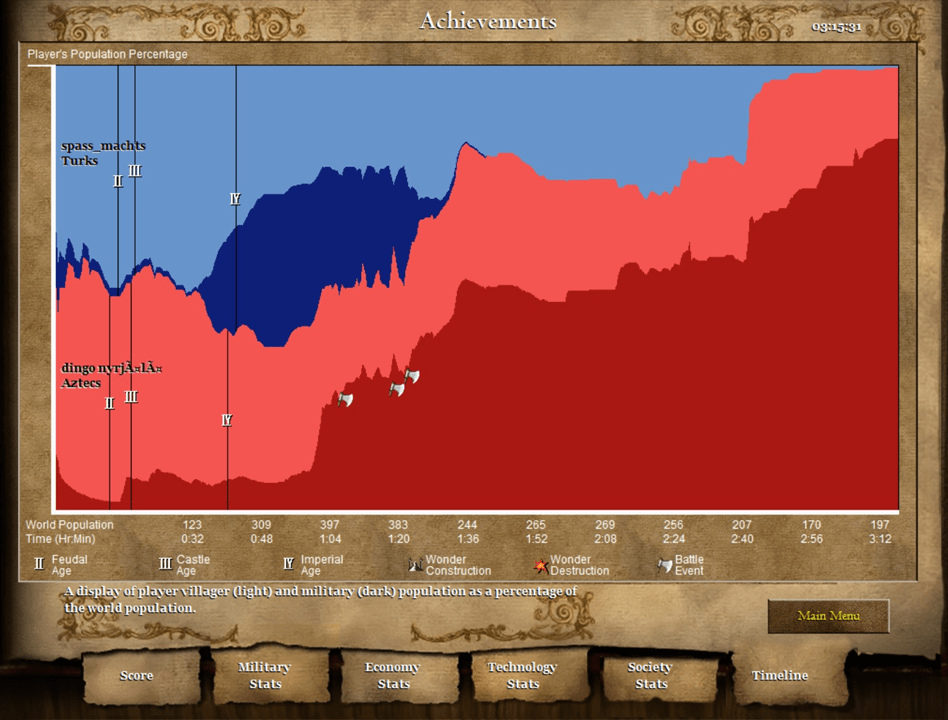
In this match of Age of Empires 2, the red player (Aztecs) managed to decimate the blue player (Turks) military units early on. Since without an army it was impossible for the blue player to secure enough resources to perform a comeback, for the next 2 hours the blue player was in a pointless, hopeless match. Kudos for not abandoning, though!
Autochess games suffer greatly from this effect, due to the following reasons:
Resources lead to victories, victories lead to resources
As you know, in autochess each player builds a team based on successive battles. Better battle performance will grant more gold, which is the resource used to buy units, perform shop rolls, etc…
Similar to the cases we’ve already explained, this means that players that achieve early dominance will be able to to obtain more gold, use it to get better units and get more victories and gold, therefore increasing their team power faster than the rest.
‘But players can be lucky or unlucky, generating a factor that compensates for the advantage of having more resources early on‘, you may be considering.
Unfortunately, this is a flawed logic, because of 2 main reasons:
(1) Having more resources means more adaptability: The dominant players will be able to leverage on them to re-adapt their team, therefore outperforming the rest on a randomness-driven scenario.
(2) Resources allow to buy more rolls, which diminishes the deviation generated by each individual roll.
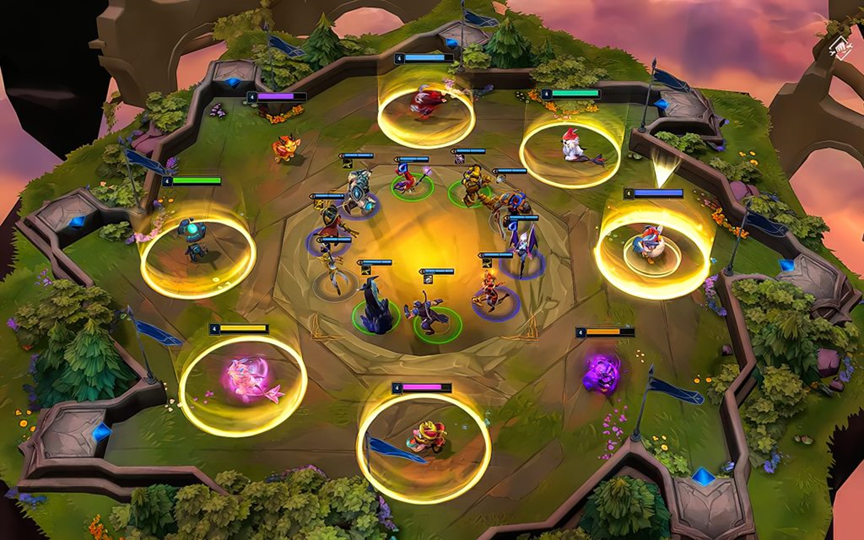
TeamFight Tactics attempts to decrease the snowball effect by introducing, among other mechanics, the Carousels: rounds where all players pick a character from a list, and where the players that are losing (i.e. have less health) get to choose first. While these mechanics doesn’t solve the issue entirely (and makes that some players aim to lose early on purpose to then comeback on the first pick), it decreases it to manageable levels.
Luck factor.
The previous point goes into maintaining and increasing dominance once it has been achieved early on, but another source of frustration is that luck is a huge factor in achieving early dominance.
This means that your strategic skills and smarts can be completely invalidated by a couple of bad rolls at the beginning of the match. And there’s nothing that competitive players hate more than having their match stolen by factors outside the pure clash of abilities.
As an antithesis, Poker also has resource management, and luck factor determines the victory (on a specific round). But unlike Autochess, resources can’t override luck, and early victories don’t affect the later chance of winning.
Compared to PC, on mobile is much harder to keep the player focused for a long period of time on a single session. And having a very long minimum session kind of goes against the premise of being able to play anywhere which is a primary strength of mobile as a gaming platform.
This is a problem for autochess games since a single match can last for 30-45 minutes of synchronous, nonstop gameplay.
Excessive length also presents the issue that, for a top competitive layer (thinking eSports here) it makes inviable the possibility of running multiple matches (the best of three...), which would allow to counter the effect of luck on a tournament.

The knockout mode in Dota Underlords aims to make the game more accessible by skipping the slow beginning of the match (you start with a pre-setup army), and by simplifying the health and fusion systems. This shortens the matches to ~15 minutes, which is still too long for mobile, but better than 30. The problem is that it also increases the snowball effect, since the match has less turns to allow comebacks, and makes any mistake (or a bad roll) way more punishing.
‘Isn’t the solution just make the match shorter?’, you’re probably wondering. Unfortunately, there are several reasons that make this more challenging to the core design than what it seems:
Because in autochess the player builds its team from scratch, at the beginning of each match there are several turns to setup team foundations.
Removing these early decisions severely decreases the teambuilding possibilities, decreasing overall depth.
Also, each setup phase between clashes requires a minimum time to think and perform the actions. In the last turns of a match, the game can become quite demanding on thinking and input speed.
Matches require a minimum amount of turns to compensate the weight of a single lucky/unlucky roll over the chances to win.
Because the possible units for teambuilding appear on random rolls, the less turns there are the more luck factor the game will suffer, and as a consequence the less important the player’s strategic skills will be.
And if there are few turns, there are also less chances for comebacks. Because it means that players will have less setup phases to adapt and catch a player that has obtained an early advantage.
Finally, since the match involves 8 players, it requires a minimum of turns so that they all can fight between each other…
Nevertheless, I don’t consider this a critical issue because Dota has been able to change this specific point on the knockout mode without sacrificing too much in terms of depth.
PC/Console approach to free-to-play is generally soft (i.e. primarily based on cosmetics, avoid pay-to-win…), while mobile tends to be quite hardcore in comparison.
The softness of PC monetization is even more core to companies such as Valve and especially Riot Games, to which the “no monetization bs” is part of the brand values. This would be very hard to change without harming their reputation.

Same as in most autochess games, in TeamFight Tactics the players can only pay for different cosmetics and for a Battle Pass. Without the massively huge and engaged audience of League of Legends, this monetization approach isn’t able to generate meaningful revenue.
This is not exclusively because we mobile-first devs are a ruthless wallstreet folk which will use every dirty trick in the book to get a bit extra money… but also because mobile games are locked in competition for paid installs.
This requires us to get as much revenue as possible from users, as fast as possible, in order to reinvest into players to keep on growing or avoid withering.
The business model of League of Legends or Fortnite is based on their extreme popularity: They already have massive amounts of highly engaged active users, so their strategy is to keep them playing and have a monetization system that, while doesn’t make as much money from the players as it could do on the short term, generates a decent amount of revenue over a longer period of time.
Games that have this soft f2p approach have it very hard to reach enough ARPPU to make paid users profitable, given the insanely high mobile CPIs.
This may not be an issue to big IPs and games that are able to bring many organic players (Fortnite, League of Legends…), but it is a big issue for those that can’t attract such a big number of players due to their organic appeal.
Due to its core characteristics (strategic, number-based, complex…), Autochess is unlikely to be a massive appeal product, and therefore won’t fit into the cosmetics model. It’s a game that will have a smaller audience of highly engaged players, and therefore will require a more aggressive monetization to reach similar results.
The history of the autochess genre serves as an example of the risks of design endogamy: The devsphere rushed to clone Auto Chess, and before a year all the major contenders were in the board.
But that speed came at a cost: None of these projects has brought the concept much further than its original conception, and in doing so they haven’t solved any of the core issues.

The folks at Riot games developed the TeamFight Tactics in less than 5 months. This allowed them to release while the hype was still at its peak… but it also meant it added just a couple of improvements, and it’s otherwise very similar to the original Auto Chess mod.
After seeing all these projects fail to meet the big expectations that were placed on them, the question is if perhaps the best approach was to avoid rushing, and instead tackle the genre with a title that is not a clone, but rather a more groomed, accessible and innovative successor of the original idea.
In our next article on this series will make an attempt to see how such a game could be, rethinking the spirit and fresh design ideas of autochess to solve the issues mentioned above. (May take a while though, I want to focus on smaller articles for a couple of months…)
Meanwhile, if you want to read more about this genre, we suggest you these awesome articles from the folks at DoF: Why Auto-Chess can’t monetize – and how to fix that and How Riot can turn TFT into a billion dollar game
These articles wouldn’t have been possible with the collaboration of ~300 members of the reddit communities of the different auto chess games who provided us with feedback and data. You folks have been incredible solving all our doubts. One thing that this genre has is some of the most awesome players around.
So big kudos for Brxm1, Erfinder Steve, Xinth, Zofia the Fierce, STRK1911, LontongSinga22, bezacho, hete, NeroVingian, marling2305, NOVA9INE , asidcabeJ, Eidallor, Rhai, Lozarian, bwdm, Toxic, Ruala, Papa Shango, MrMkay, Dread0, L7, kilmerluiz, Amikals, Sworith, Tankull, B., hete, Bour, Denzel, DeCeddy, Diaa, hamoudaxp, Benjamin “ManiaK” Depinois, Katunopolis, DanTheMan, MikelKDAplayer, 0nid, Tobocto, Tiny Rick, phuwin, Alcibiades, triceps, d20diceman, shadebedlam, stinky binky, Tutu, Myuura, suds, Kapo, Hearthstoned, Engagex, Pietrovosky, Daydreamer, Doctor Heckle, Ignis, ShawnE, NastierNate, LeCJ, Nene Thomas, Chris, trinitus_minibus, Nah, Kaubenjunge1337, Mudhutter, Asurakap, Nicky V, shinsplintshurts, bobknows27, Willem (Larry David Official on Steam), Jonathan, Dinomit24, Monstertaco, GangGreen69, Veshral Amadeus Salieri (…lol!), Kuscomem, Cmacu, Pioplu, Dilemily, qulhuae, Ilmo, MarvMind, facu1ty, crayzieap, Saint Expedite, Lobbyse, Lukino , tomes, Blitzy24, Mcmooserton, magicmerl, i4got2putsumpantzon, radicalminusone, Pipoxo, Kharambit, Bricklebrah, Rbagderp, Merforga, Superzuhong, Mo2gon, MoS.Tetu, MeBigBwainy, Zokus, CoyoteSandstorm, Stehnis, Noctis, Fkdn, Ray, Fairs1912, Fairs1912, Krakowski, HolyKrapp, Damadud, Pentium, Mach, Mudak, CaptSteffo, jwsw1990, Omaivapanda, Inquisitor Binks, Jack, yggdranix, GoodLuckM8, Centy, Prabuddha (aka Walla), dtan, Philosokitteh, Doms, ZEDD, Calloween, Synsane, Kaluma, GordonTremeshko , Djouni, DOGE, haveitall, ANIM4SSO, Task Manager, Submersed, BAKE, Viniv, La Tortuga Zorroberto, BixLe, Rafabeen, Blzane, bdlck666, FatCockNinja86, R.U.Sty, Yopsif, blesk, Quaest0r, FanOfTaylor, StaunchDruid, Rushkoski and everyone else that took some minutes to help us out on the article.
You May Also Like